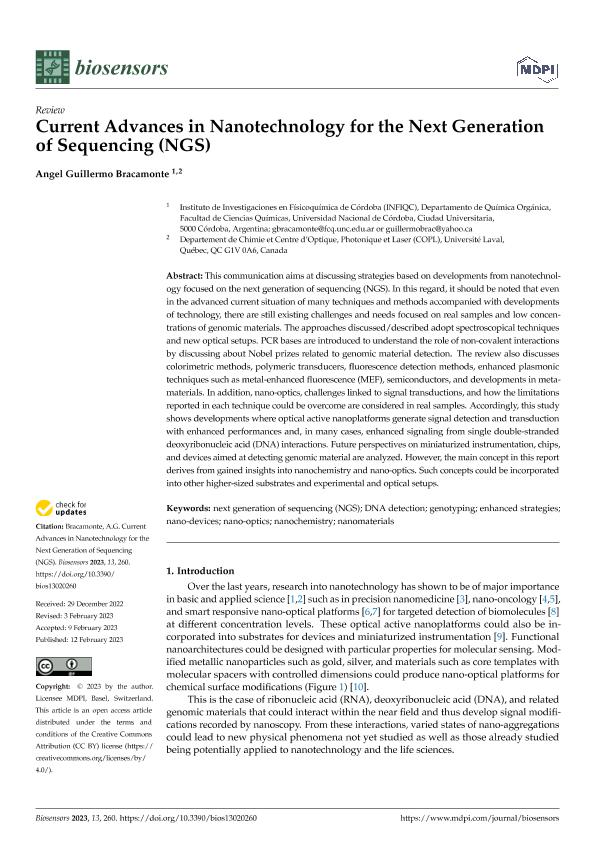Mostrar el registro sencillo del ítem
dc.contributor.author
Bracamonte, Angel Guillermo

dc.date.available
2024-02-09T15:23:09Z
dc.date.issued
2023-02
dc.identifier.citation
Bracamonte, Angel Guillermo; Current Advances in Nanotechnology for the Next Generation of Sequencing (NGS); Multidisciplinary Digital Publishing Institute; Biosensors; 13; 2; 2-2023; 1-27
dc.identifier.uri
http://hdl.handle.net/11336/226656
dc.description.abstract
This communication aims at discussing strategies based on developments from nanotechnology focused on the next generation of sequencing (NGS). In this regard, it should be noted that even in the advanced current situation of many techniques and methods accompanied with developments of technology, there are still existing challenges and needs focused on real samples and low concentrations of genomic materials. The approaches discussed/described adopt spectroscopical techniques and new optical setups. PCR bases are introduced to understand the role of non-covalent interactions by discussing about Nobel prizes related to genomic material detection. The review also discusses colorimetric methods, polymeric transducers, fluorescence detection methods, enhanced plasmonic techniques such as metal-enhanced fluorescence (MEF), semiconductors, and developments in metamaterials. In addition, nano-optics, challenges linked to signal transductions, and how the limitations reported in each technique could be overcome are considered in real samples. Accordingly, this study shows developments where optical active nanoplatforms generate signal detection and transduction with enhanced performances and, in many cases, enhanced signaling from single double-stranded deoxyribonucleic acid (DNA) interactions. Future perspectives on miniaturized instrumentation, chips, and devices aimed at detecting genomic material are analyzed. However, the main concept in this report derives from gained insights into nanochemistry and nano-optics. Such concepts could be incorporated into other higher-sized substrates and experimental and optical setups.
dc.format
application/pdf
dc.language.iso
eng
dc.publisher
Multidisciplinary Digital Publishing Institute
dc.rights
info:eu-repo/semantics/openAccess
dc.rights.uri
https://creativecommons.org/licenses/by/2.5/ar/
dc.subject
DNA DETECTION
dc.subject
ENHANCED STRATEGIES
dc.subject
GENOTYPING
dc.subject
NANO-DEVICES
dc.subject
NANO-OPTICS
dc.subject
NANOCHEMISTRY
dc.subject
NANOMATERIALS
dc.subject
NEXT GENERATION OF SEQUENCING (NGS)
dc.subject.classification
Química Analítica

dc.subject.classification
Ciencias Químicas

dc.subject.classification
CIENCIAS NATURALES Y EXACTAS

dc.title
Current Advances in Nanotechnology for the Next Generation of Sequencing (NGS)
dc.type
info:eu-repo/semantics/article
dc.type
info:ar-repo/semantics/artículo
dc.type
info:eu-repo/semantics/publishedVersion
dc.date.updated
2024-02-09T12:29:06Z
dc.identifier.eissn
2079-6374
dc.journal.volume
13
dc.journal.number
2
dc.journal.pagination
1-27
dc.journal.pais
Suiza

dc.journal.ciudad
Basilea
dc.description.fil
Fil: Bracamonte, Angel Guillermo. Consejo Nacional de Investigaciones Científicas y Técnicas. Centro Científico Tecnológico Conicet - Córdoba. Instituto de Investigaciones en Físico-química de Córdoba. Universidad Nacional de Córdoba. Facultad de Ciencias Químicas. Instituto de Investigaciones en Físico-química de Córdoba; Argentina. Laval University; Canadá. Universidad Nacional de Córdoba. Facultad de Ciencias Químicas. Departamento de Química Orgánica; Argentina
dc.journal.title
Biosensors
dc.relation.alternativeid
info:eu-repo/semantics/altIdentifier/url/https://www.mdpi.com/2079-6374/13/2/260
dc.relation.alternativeid
info:eu-repo/semantics/altIdentifier/doi/https://doi.org/10.3390/bios13020260
Archivos asociados
